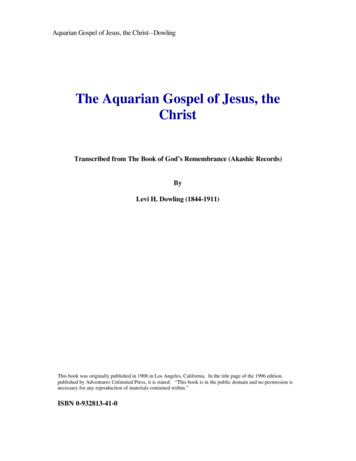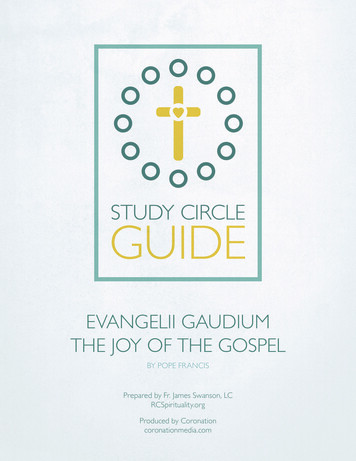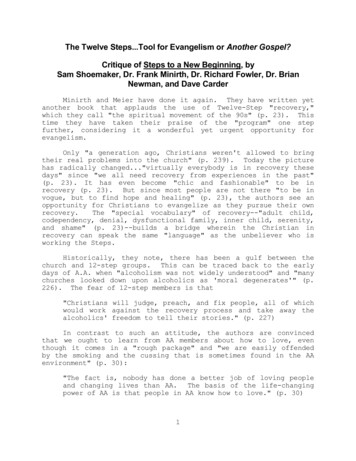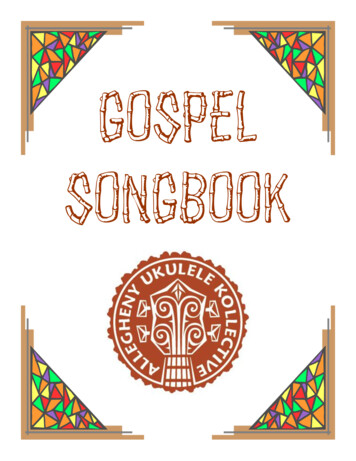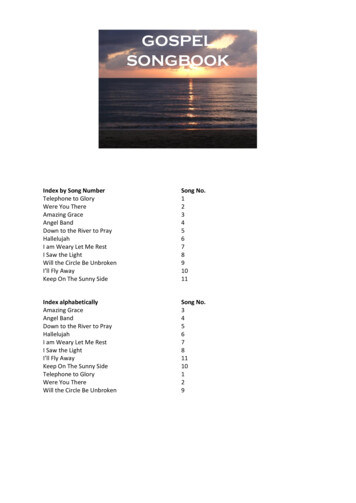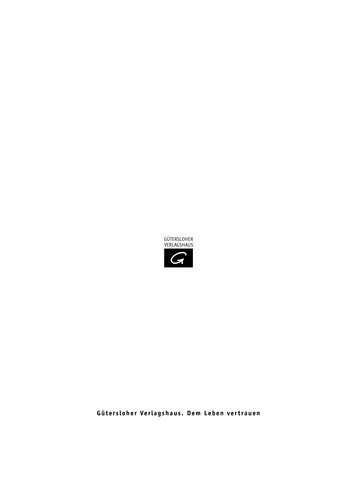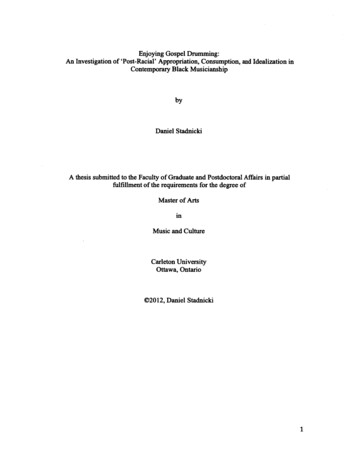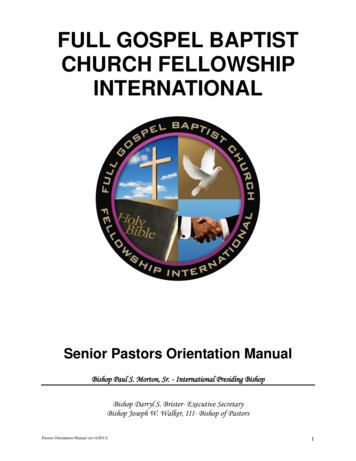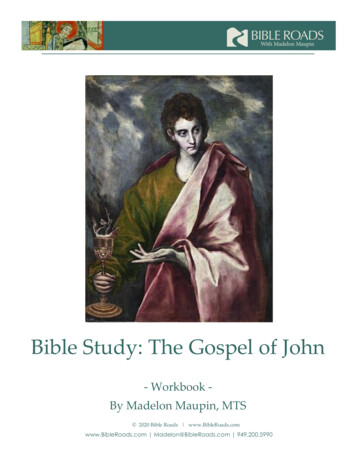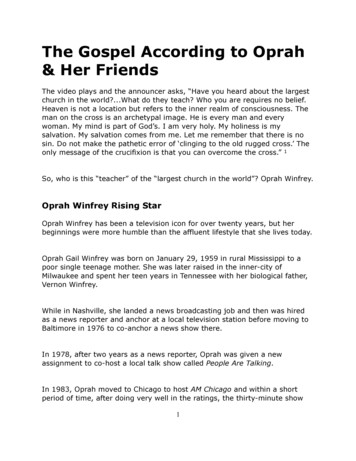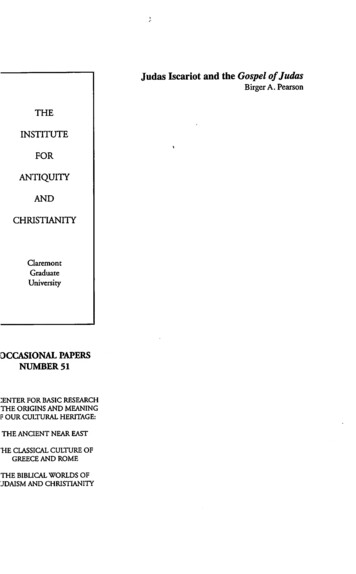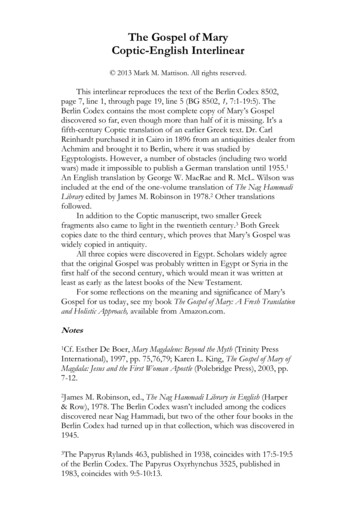
Transcription
The Gospel of MaryCoptic-English Interlinear 2013 Mark M. Mattison. All rights reserved.This interlinear reproduces the text of the Berlin Codex 8502,page 7, line 1, through page 19, line 5 (BG 8502, 1, 7:1-19:5). TheBerlin Codex contains the most complete copy of Mary’s Gospeldiscovered so far, even though more than half of it is missing. It’s afifth-century Coptic translation of an earlier Greek text. Dr. CarlReinhardt purchased it in Cairo in 1896 from an antiquities dealer fromAchmim and brought it to Berlin, where it was studied byEgyptologists. However, a number of obstacles (including two worldwars) made it impossible to publish a German translation until 1955.1An English translation by George W. MacRae and R. McL. Wilson wasincluded at the end of the one-volume translation of The Nag HammadiLibrary edited by James M. Robinson in 1978.2 Other translationsfollowed.In addition to the Coptic manuscript, two smaller Greekfragments also came to light in the twentieth century.3 Both Greekcopies date to the third century, which proves that Mary’s Gospel waswidely copied in antiquity.All three copies were discovered in Egypt. Scholars widely agreethat the original Gospel was probably written in Egypt or Syria in thefirst half of the second century, which would mean it was written atleast as early as the latest books of the New Testament.For some reflections on the meaning and significance of Mary’sGospel for us today, see my book The Gospel of Mary: A Fresh Translationand Holistic Approach, available from Amazon.com.Notes1Cf. Esther De Boer, Mary Magdalene: Beyond the Myth (Trinity PressInternational), 1997, pp. 75,76,79; Karen L. King, The Gospel of Mary ofMagdala: Jesus and the First Woman Apostle (Polebridge Press), 2003, pp.7-12.2James M. Robinson, ed., The Nag Hammadi Library in English (Harper& Row), 1978. The Berlin Codex wasn’t included among the codicesdiscovered near Nag Hammadi, but two of the other four books in theBerlin Codex had turned up in that collection, which was discovered in1945.3ThePapyrus Rylands 463, published in 1938, coincides with 17:5-19:5of the Berlin Codex. The Papyrus Oxyrhynchus 3525, published in1983, coincides with 9:5-10:13.
SourcesThe Coptic text and reconstructions included in this interlinear arebased on the following critical sources, which were developed byscholars examining the original manuscript in Berlin. Readersinterested in learning more about the text are encouraged to consultthem directly:Walter C. Till and Hans-Martin Schenke, Die gnostischen Schriftendes koptischen Papyrus Berolinensis 8502 (Akademie Verlag), 1972,pp. 62-79; 342-366Anne Pasquier, L’Évangile Selon Marie (Les Presses de l’UniversitéLaval), 1983, pp. 29-47; 109-118R. McL. Wilson and George W. MacRae in The Coptic GnosticLibrary: A Complete Edition of the Nag Hammadi Codices, Vol. III, ed.By James M. Robinson (Brill), 2000, pp. 456-471; 495-542Christopher Tuckett, The Gospel of Mary (Oxford UniversityPress), 2007, pp. 86-106Particular thanks to Michael W. Grondin, author of the on-lineresource Grondin’s Interlinear Coptic/English Translation of the Gospel ofThomas, for his invaluable feedback and constructive criticism.This document was first published on-line on July 21, 2013, and lastupdated on October 1, 2013. Please forward notices of typographicalerrors or suggested corrections toSymbols[ ] {}‘’Gap in the textEditorial correction of a scribal errorLetter erroneously added by the scribeLetter or letters inserted over the line by the scribe
12345678910111213141516171819202122[z]7[ ] jebe destroyed ornot?”Saidthe-Savior neach-otherwithmauauwoneu.na.bwl ebole.themandagain they-will-dissolveintotou.nouneMmin mmo.oujete.their-roottheir own,forthevusisn.culhes.bwl ebole.na.natureof-matterit-dissolvesinto-the things r!”pejepetrosna.fje5wsak.taSaidPeterto-him this:“As youmo.ne.5wbnimjwm.pi.ke.ouatold-us concerning-thing everytell of-the-other-oneero.noupep.nobem.p.kosmosto-us: Whatisthe-sinof-the-world?”pejep.SWRjemNnobe šop alSaidthe-Savior this: “Nosinexists, butlaNtwtNpe reM.p.nobeeteyouit is who make the-sinwhentN.eireN.ne neN.t.vusisn.t.mNtyou-dothose (things) like the-natureof-thenoeiket ou .mouteero.sjep.noadulterywhich is-calleditthis: the-sin.beetbepa!af.eiNqip.agacOBecause of thishe-came viz the-Good5ntetM.mhtešanavusisintoyour-midstup to the things re—withinetes.nouneetiaf.ouw5 tN.šwsaid-hethis: “Because die,foryou-love
verno!mare.f.Rnoei[a.c]ulh [jp]e ou.understands let-him-understand! has nottherethe-image,e.af.eiebol 5nou.paravusistowhich-it-came out from (something)-contrary to nature.tešare.ou.tarayhšwpeĂMThena-disturbance comes into beinginp.swmathr.fetbepa!a!.jo.snhthe-bodyall. Because ontent of-heartauwetetN.o N.n.attwteteandif you-be discontentedyoutN.thtmenN.na5r.Mp.inep.inecontent nevertheless in-the presence-of ture. him-hear!”Whenref.jena!nqip.makariosaf.ashe-said these (things) vizthe-Blessed One he-greetpazeMmoouthr.ouef.jwMmo’‘’ s’’ed—all-of them you.Bewarelet ng—this:eis5hpem.pe!.saheis5hpeM.‘Lookhere in-this-direction!’ or ‘Look hereinpeei.map.šhregarm.p.rwmeef.this-place!’ the-SonForof-the-Human hešopmpetN5ounoue5.thutNexistswithin you.Follow-youNsw.fnet.šineNsw.fsena.after-him. Those who-seekafter-himthey willqNT.fbwkqeNtetN.tašeoeišfind-him.Gothenand you-to -kingdom.Do not-
ose5ra!parapenlayanyrulesdownbeyond whatt.a!.toš.Fnh.tNoudeMpR. noI-appointedto-you,nordo not-give (a) f.jena!af.bwkntooudeWhen-he-said these (things), he-went.theyButneu.Rlupeiau.rimeMp aeu.they-grieved (and) they-weptgreatly.Theyjwmmosjenn.aš sNtN.tašeoeišN.up tothe-Gentileswe-to uMof-the-Human?Ifthat onepou. soero.fn.aš N5eanoneu.they did not-spare him,howwetheyna. ounas.aspazemmoouthr.ou(and) she-greeted—all-of eto-her-brothersthis:“Do not-weepauwmpR.RlupeioudeMpR.R5htanddo not-grieve,nordo forwill-ben.MmhtNthr. t nauwns.Rskepawith-youall-of youandit hetwt.Naf.aa.nN.rwmentare.maprepared-us (and) ysaidthese (things), she-turned oodandthey-started[scai]n.R.gum[n]aze5a pran.N.šato-debateaboutthe-words[y]e m.p.[SWR]of-the-Savior.
.soounjenere.p.SWRouaš.ewe-knowthatthe-Savior loved-youn5ouoparap.ke.seepen.S5!memore thanbeyondthe-other-remainder e-words erthese (things) which-know—ouN.n.anon anoudempN.sotm.‘o’’uwenotnor we have weredvizMarysaid-shejep.echperw.tN .na.tamathuthis: iN.jwna.uit.”Andshe-started to-say s:“I,”said-she, onandIjoo.sna.fjep.JSa!.nauero.kMsaidto-him this: ‘Lord, ’He-answeredja.fna.!jena!at.eje Nte.kimansaid-he to-me this: ‘Blessed are-you, for you-waver e-place auevoto-himthis:‘Lord, nowwho-seestheromaef.nauero.f 5N te.2uyh h ethe-spirit?’ He-answeredvizthe-Saviorja.fjeef.nauan5Nte.2uyh ousaid-he this: ‘He-sees -spirit, butthe-mind which-exists5nteu.mhtem.pe.u.snauNto[f pet].inbetweenthe-twoit thatnauevoromaau[w]Ntofp[et ]seesthe visionanditthat ’Pages 11 through 14 are missing.
kepitNthis: ‘I did not-seeyouyou-goingdowntenoude i qolere.hp’’’ eup.Whythen you-tell a lie (since) you-belong e-soulja.sjea!.naueroMpe.nau ero.!said-shethis:‘I-sawyou did not-seemeoudempe.eimeero.eineei.šonordid you-knowme.I-wasopneN5Bswauwmpe.souwn.tto you a garmentand you did not-recognize-me.’Ntares.jena!as.bwkes.telhlWhen she-said these (things)she-wentshe-rejoicingN5ouo palinas.eietNt.me5greatly.Againshe-came towards hand of the omnteN.n.e3ousiatetou.m‘o’uthirdpowerwhich aidmosjeere.bhketwn5n[o]u.po—this: ‘you-going where?Innhriaau.ama5teMmoau.[a]ma5wickedness you do ough I-did gh I-did not-bind. They did gnizedbwl ebolm.p.thrfeitenapdissolvingthe-All,both things of the[ka5]earth
]Ntere.te.2uyhouandthings of the-heaven.’ When-the-soulwsFN.t.me5šomnteN.n.e3ousihad overcomethe-thirdpoweraas.bwkep.sa et.me5sNtet.epiisthe-Darkness; urthisthe-Zeal of-themout.me5 etet.mNteroN.t.sar3Death; the-fifthisthe-Kingdom Wrathful.These onqueror-space?’ vercomeandmy-desireas.jwk mou‘5N’’ ou.[kosm]osNtau.bolt’’ eit-died.Ina-worldthey-released
smos [au]w5Nou.froma-worldandinatuposebol 5nou.tuposet.Mtypefroma-typewhich isp.sa n.t.peauwt.mRren.t.Bšeet.aboveand the-chain of-the-forgetfulness thatšooppros ouo!šjinMpinauexistsfor a time.From this time .SWRthese (things) she-kept ith-herup -brothersthis:“Saywhat-you-saymmof5a p.raN.ne.ntas.j[o]o.u—aboutwhat she-said;anokmen ena!ešjeni.sboouthe-Savior said these (things), seem to be er-ideasare.” He-answeredšBnqipetrospeja.f5a sked-them anen.na.to-usinpublicoutnot? istenall-of usnsw.sNt a f.sotp.sn5ouoero.nto-her?Did he-choose-her more thanus?”
tre5!eek.Peter,“My-brother think—I heei.ji qole.p.SWRaf.ouheartorI-tell a lie concerning-the-Savior?” visaid-he to-Peterjepetrejin ene5k.šopn.refthis: “Peter,alwaysyou-have beennouqs sna3iosNtknimSaviorBut uvery well. Because ofthishe-loved-her more thanoero.nmallonmar.N.šipeNTN.us.Ratherlet-us-be ashamed, ntN.jpo.fn.ankata ceNtafwe-acquire-himin-uslikewhat he5wnetoot.NNtN.tašeoeišcommandedus,we-to id-he.”When-
12345[leueiLevibwkgode—[ic]19jen]a!auwau.Raryei N.s
1Cf. Esther De Boer, Mary Magdalene: Beyond the Myth (Trinity Press International), 1997, pp. 75,76,79; Karen L. King, The Gospel of Mary of Magdala: Jesus and the First Woman Apostle (Polebridge Press), 2003, pp. 7-12. 2James M. Robinson, ed., The Nag Hammadi Library in English (Harper & Row), 1978. The Berlin Codex wasn’t included among the codices discovered near Nag Hammadi, but two of .
